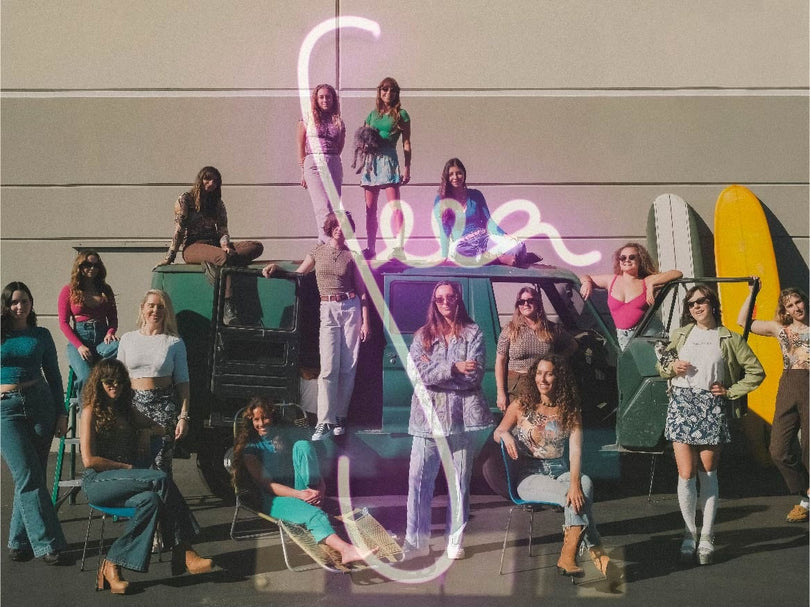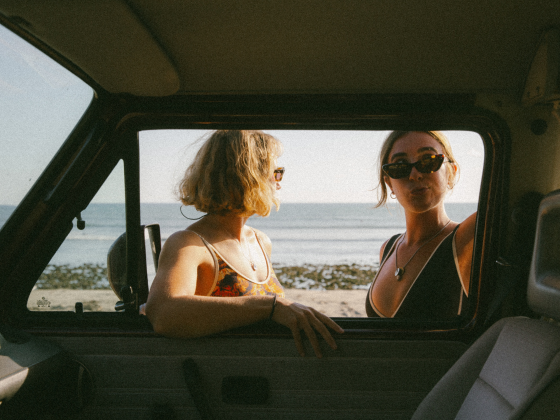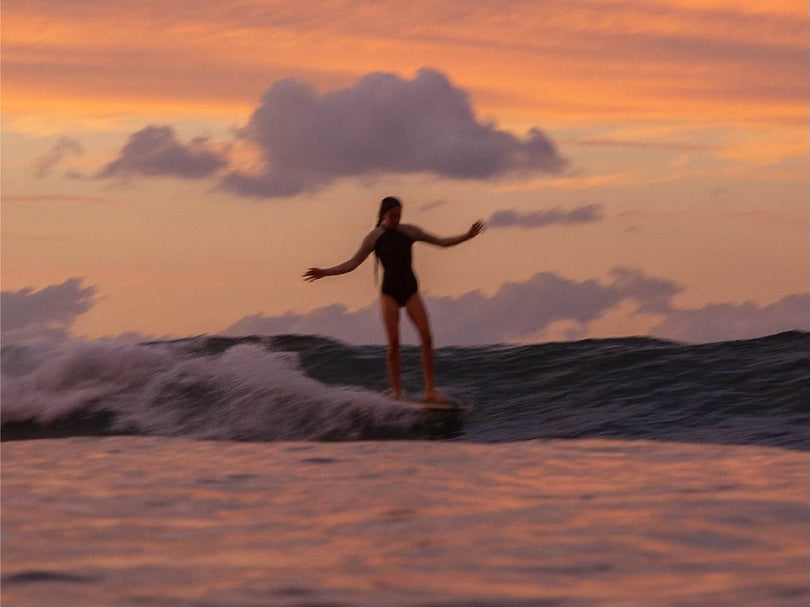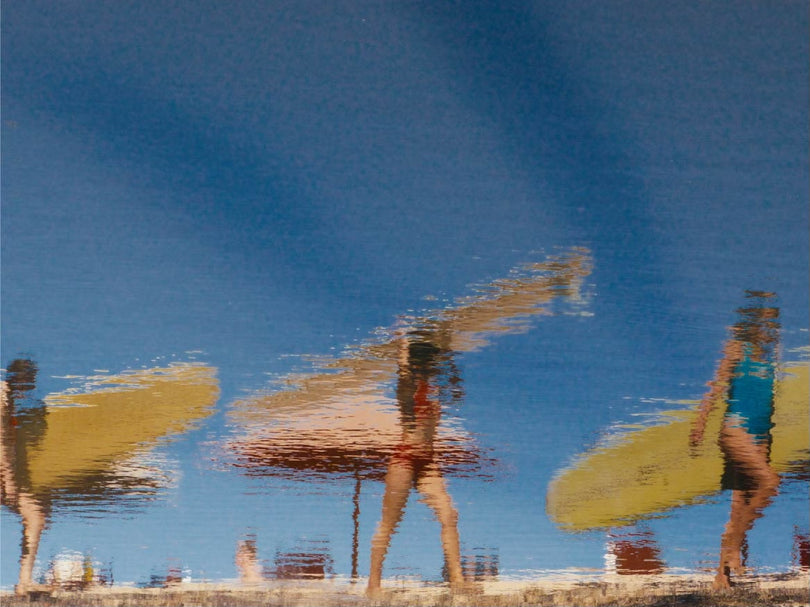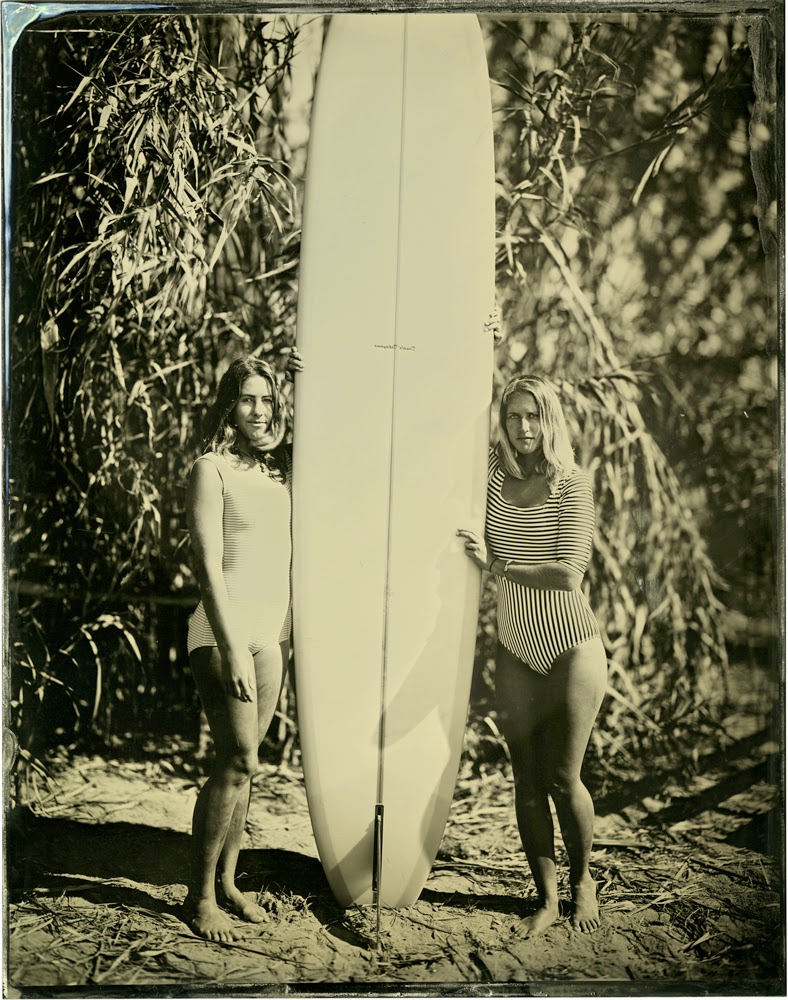 |
| Karina Rozunko wearing the Tofino in Blue Tide and Charlotte Shanahan wearing the Zuma in Black Stripe. Photo by Joni Sternbach. |
At the tap of our camera phones, pixels light up to become images in our hands pretty much anywhere we are and any time we want. It’s easy to forget that taking photos used to be a lot of work. The click of a real button, the sound of film winding, the thoughtful marinating in a bath of chemicals and then hanging to dry. Actually taking the photo? That’s the easiest part says Brooklyn, New York-based photographer Joni Sternbach.
“It's the preparation that takes the most time and scrutiny,” she explained. “Making sure my chemistry is ‘groomed,’ mixed well, aged to perfection (if only it were like a fine wine) all contribute to giving the end result its character.”
Joni Sternbach’s photographs using a large-format camera and the nineteenth-century wet-plate collodion process in which she hand-pours the plates and develops on location are immediately captivating. Her otherworldly tintype portraits of surfers on the shore have been compiled into the art books: “Surfland” published in 2009 and most recently “Surf Site Tintype” published this year.
On one of Sternbach’s trips to the West coast, she met Seeababe Karina Rozunko and her friend Charlotte Shanahan on the beach in San Clemente (wearing Seea surf suits, naturally). The photos that resulted from their encounter took our breath away in the textures of the print, and how authentically vintage they appeared.
We caught up with Sternbach to find out more about why she loves to shoot real photographs and how surfers came to be her subjects.
 |
| From left, Charlotte Shanahan and Karina Rozunko taken in San Clemente. Photo by Joni Sternbach. |
How did the portraits that you took of Karina Rozunko and Charlotte Shanahan at San Onofre come about?
I met Karina through the surfer, Jen Smith. I was headed south to San Diego and San-O was on the way, so we decided to meet there. I made just a couple of plates when 'the ranger' showed up. He took one look at our dark tent and decided we were a big production and that we needed a permit.
I explained that I am an artist, not a commercial venture and that I wasn't hired by a company to make these pictures, but that I do it all on my own. That did not faze him in the least. He watched over us like we were teenagers about to strip naked-and skinny dip illegally in public. It was rather ridiculous. He allowed me to take one film shot… and to be honest, if he hadn't hassled the shit out of us, I might never have made that picture!
We found another spot to shoot at that was quite beautiful, filled with the emptiness of western imagination.
 |
| Karina Rozunko wears the Tofino. Photo by Joni Sternbach. |
Tell us about your career as a photographer. When did you start shooting and discover that you liked photography as your medium of choice?
I first started taking pictures in college. It was a required course at the art school I attended. My first successful picture was a still life of a cheesecake with a slice cut out of it. Not that I'd advise anyone out there to base a career choice on a single image like that, but something about how ordinary the picture was, combined with the black and white chemistry and magic of watching the image develop in the darkroom struck me and stuck with me.
I switched my major from fine arts and made a choice to be a photographer. I studied with people who mostly shot on the street and learned to tell a very personal story by pointing the lens outward. My first body of work was (made over a period of time) on the subway. Back in the ‘70’s, NYC was a tough place and photographing in the subways was illegal. I used a quiet range-finder camera that I wore around my neck under my coat with a preset focus. I guesstimated the image frame based on the wide-angle lens I was using. Raising the camera to my eye drew a very different response from subjects, so I tried to minimize that action.
 |
| Karina Rozunko wears the Tofino. Photo by Joni Sternbach. |
How did you discover this method that you currently use of the wet-collodion process?
I learned the wet-collodion process, which includes the tintype from John Coffer, one midday summer in 1999. John is an unconventional man who lives a 19th century life on a farm in upstate NY. He teaches workshops on the process and hosts a big jamboree on his farm every summer for all the crazy wet-platers out there in the world.
What were your first photos using the medium?
I started shooting near the ocean, where I had been making these close-up, abstract images of the ocean surface, called 'Ocean Details.' Making pictures by the shoreline was a practice I was becoming committed to. The wet-plate medium has very specific sensitivities and insensitivities that make photographing certain subjects challenging, however it reads textures really well, which meant there had to be a strong subject amidst the landscape. I found remnants of civilization and life along the shoreline, so I aptly named my first series "Abandoned." They were haunting ambrotype and tintype images that felt like they could have been taken a hundred years ago.
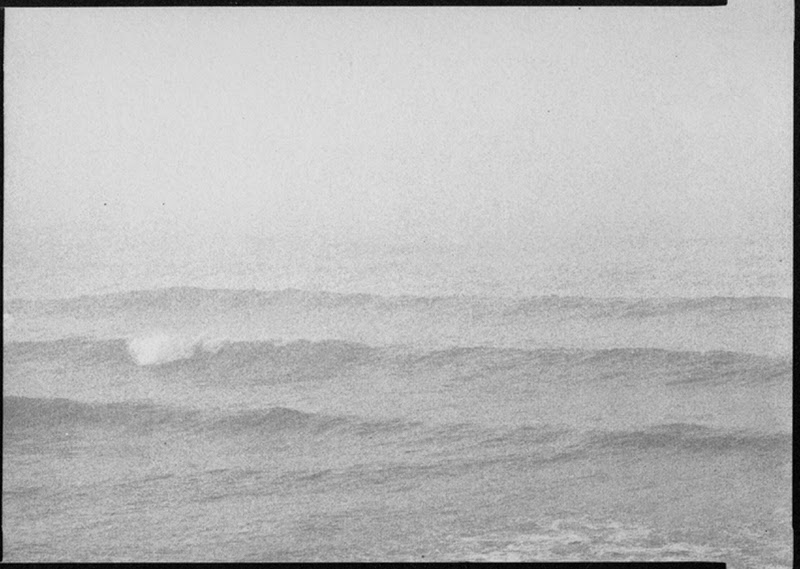 |
| Ocean details by Joni Sternbach. |
 |
| Ocean details by Joni Sternbach. |
What fascinates you about it?
The medium is wet which makes it very specific; it's super slow, so all my exposures are relatively long. Long exposures mean capturing time in motion and that's yields unpredictable and exciting results. It's also a hand poured process so the hand is involved in a way it's not in standard photography. The way I pour a plate, the way I develop my plate, fix, rinse and wash it, all contribute to the end result.
Joni Sternbach - Photographer from Johnny Abegg Films on Vimeo.
How did you begin taking photos of surfers?
I like to say … that surfers came to me. Initially, I considered them interlopers into my pristine, abstract landscape. Then I began to see that this was a place we were all interacting in, that it was a shared environment and that it was important for me to pay attention to that. These people (surfers) inhabited the landscape; maybe they were there for a reason! To me, surfers are primal; they are so much a part of the ocean landscape where I was shooting at Ditch Plains, that I am surprised I avoided them so long. But maybe, more importantly is that what I am trying to do—by photographing surfers fits so well with what they are trying to do—just by being surfers.
What is it about surf culture and environment that turned out to be the perfect subject matter?
As the series developed, I began to understand this subculture of surfers as people, who on a regular basis, seek a connection with nature and unabashedly engage in their quest for joy. That in itself was exciting and intriguing. Making the portraits of surfers seemed to capture something that was both primitive and contemporary. Their surfboards appeared like symbols or totems, revealing individual character and the wet suits and clothing were also symbolic, revealing time, place and fashion. Because the photographs are positives, the text reads backwards. This affects the way you understand the picture—glaring logos appear more like design or hieroglyphics and brand names are no longer prominent.
 |
| Karina Rozunko wearing the Tofino in Blue Tide. Photo by Joni Sternbach. |
Have you tried surfing?
I was pushed into my first wave in Australia by Lauren Hill. She made it a little bit of a mission to get me on a board and I am so glad she did. I didn't stand during that brief ride but I totally got the feeling of what it's like to ride with the ocean. There's nothing like it.
What's unique in your women surf subjects?
I love photographing and working with women. I'm comfortable around them, maybe that shows. I couldn't say what exactly is unique in my photographs of them, but another photographer/surfer once told me early into the series that she felt my pictures empowered women. That was nice to hear!
Thank you Joni, you are an inspiration!
Check out Joni Sternbach’s website for more information about her, and where to find her books! For all the Californians, she will be signing her latest book, "Surf Site Tintype" on May 2nd at Paris Photo LA at the D.A.P. booth.
 |
| Charlotte and Karina in full color. Photo by Joni Sternbach. |

